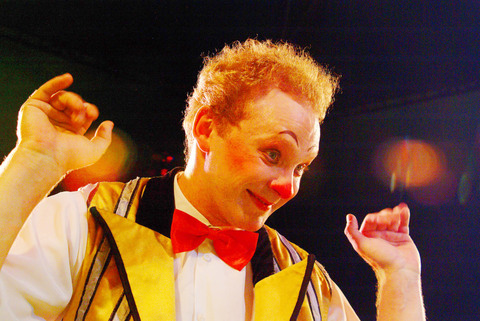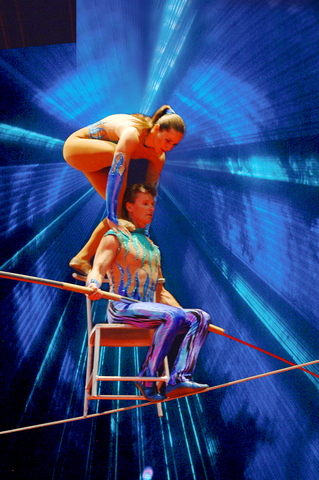They tame snarling lions, brave high wires with no safety nets, and leap through fiery hoops.
But for the Great Moscow Circus — which starts a 24-week, six-city tour of Taiwan this October — getting here could prove a more amazing feat.
“We had 21 air and sea freight containers from the US and 30 semi-trailers from South Africa,” said organizer Michael Coad.

PHOTO COURTESY OF EDGLEY INTERNATIONAL
The circus's red-and-gold tent seats 2,200 people and covers the area of a soccer field. It will take a team of 50 men working around the clock two days to erect.
The lions will be flown in from the US, the elephant is coming in a jumbo jet from Spain and the dogs are arriving from Denmark, because Taiwan's strict quarantine laws make it too difficult to bring in Russian animals, Coad said.
Tickets went on sale Tuesday for the circus, which includes acrobatic troupes, a family of jugglers who perform on Harley-Davidson motorcycles, clowns and a team of “Olympic standard” gymnasts.

But the animals are likely to prove the biggest attraction of what organizers say is the first circus to visit Taiwan since 1993.
“Western audiences don't want to see animals anymore. But Chinese audiences do,” said Coad, an executive with Australian promoters Edgley International.
He said the Great Moscow Circus lost money — a rarity — when in 2001 it performed in Singapore with a limited troupe of animals. “We found out through word of mouth it was because we brought fewer animals,” he said.
Singapore in 2001 announced a ban on circuses with performing wild animals such as tigers, lions and elephants. The ban went into effect the following year. Similar bans are in effect in several Nordic countries, India, Israel and the Australian Capital Territory.
Coad said the Great Moscow Circus was “one of the world's best” because its animals and performers are well looked after. All animals in the circus were bred in captivity, he said.
He was speaking Monday after a press conference, which featured a publicity stunt that would probably be illegal in a more litigious country.
Hungarian daredevil Laszlow Simet — who was wearing a white-and-orange Elvis suit that sparkled in the sweltering afternoon sun — did a 10-minute walk in front of Sun Yat-sen Memorial Hall on a tightrope suspended 20m in the air.
As the sound system played a drum roll, an announcer informed the audience of journalists and curious onlookers that, “this is extremely dangerous. There is absolutely no safety equipment.”
Warming up before his feat, the steely-eyed Simet was the picture of concentration.
But afterwards his hands were shaking. “It was a bit windy, but it was within the limits,” he said. “As I went I felt the wire moving.”
Still, he insisted that he was not afraid, just “nervous.”
“You don't really think too much. You concentrate so much on the work that there's no room for thinking,” said Simet, who will perform in the circus with his Russian wife, Olga.
Four awestruck children who saw his balancing act were not keen on imitating him.
“It was scary. I was afraid he would fall,” said nine-year-old Hsinzi.
Grandmother 71-year-old Wu Yang Duo-hsiao was taking the girl and her cousins for a stroll and had not expected to see Simet, who she had seen perform in Taipei two decades ago.
“It was amazing,” she said of the previous circus. “I'm definitely taking my grandchildren to this one.”
Performance Notes:
Venues and dates: In Taipei from Oct. 6 through Nov. 19 at Zhongshan Soccer Stadium (中山足球場), 1 Yumen St. Taipei (臺北市玉門街1號); Tainan from Nov. 24 through Dec. 3 at RT-Mart (Anping Branch) 42 Jyunping Rd, Tainan (台南市郡平路42號); Hsinchu from Dec. 7 through Dec. 17 at RT-Mart (Jhonghsiao Branch) 300 Jhonghsiao Rd, Hsinchu (新竹市忠孝路300號). The Great Moscow Circus will continue its tour with performances in Kaohsiung (Dec. 21, 2006 through Jan. 21, 2007), Taoyuan (Jan. 25, 2007 through Feb. 16, 2007) and Taichung (Feb. 16, 2007 through March 18, 2007)
Tickets: From NT$600 to NT$3,500 and are available through www.artsticket.com.tw. Discounts are available for group of 10 or larger are available by calling (02) 2702-8838.

One of the biggest sore spots in Taiwan’s historical friendship with the US came in 1979 when US president Jimmy Carter broke off formal diplomatic relations with Taiwan’s Republic of China (ROC) government so that the US could establish relations with the People’s Republic of China (PRC). Taiwan’s derecognition came purely at China’s insistence, and the US took the deal. Retired American diplomat John Tkacik, who for almost decade surrounding that schism, from 1974 to 1982, worked in embassies in Taipei and Beijing and at the Taiwan Desk in Washington DC, recently argued in the Taipei Times that “President Carter’s derecognition

This year will go down in the history books. Taiwan faces enormous turmoil and uncertainty in the coming months. Which political parties are in a good position to handle big changes? All of the main parties are beset with challenges. Taking stock, this column examined the Taiwan People’s Party (TPP) (“Huang Kuo-chang’s choking the life out of the TPP,” May 28, page 12), the Democratic Progressive Party (DPP) (“Challenges amid choppy waters for the DPP,” June 14, page 12) and the Chinese Nationalist Party (KMT) (“KMT struggles to seize opportunities as ‘interesting times’ loom,” June 20, page 11). Times like these can

JUNE 30 to JULY 6 After being routed by the Japanese in the bloody battle of Baguashan (八卦山), Hsu Hsiang (徐驤) and a handful of surviving Hakka fighters sped toward Tainan. There, he would meet with Liu Yung-fu (劉永福), leader of the Black Flag Army who had assumed control of the resisting Republic of Formosa after its president and vice-president fled to China. Hsu, who had been fighting non-stop for over two months from Taoyuan to Changhua, was reportedly injured and exhausted. As the story goes, Liu advised that Hsu take shelter in China to recover and regroup, but Hsu steadfastly

You can tell a lot about a generation from the contents of their cool box: nowadays the barbecue ice bucket is likely to be filled with hard seltzers, non-alcoholic beers and fluorescent BuzzBallz — a particular favorite among Gen Z. Two decades ago, it was WKD, Bacardi Breezers and the odd Smirnoff Ice bobbing in a puddle of melted ice. And while nostalgia may have brought back some alcopops, the new wave of ready-to-drink (RTD) options look and taste noticeably different. It is not just the drinks that have changed, but drinking habits too, driven in part by more health-conscious consumers and